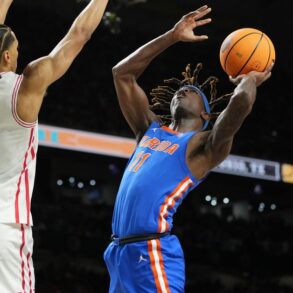
The College Basketball Crown tournament’s format could put other postseason college basketball tournaments in jeopardy. The cash prize for the participants makes the Crown a more attractive option than smaller tournaments.
Kashif Summers, former player for the DePaul men’s club basketball team, is excited for players to receive more opportunities for extra money, especially in the postseason.
“Putting that cash incentive … gives (the) opportunity to end on a high note,” Summers said.
But how did we get here?
The Crown tournament debuted late last month with Butler and Utah facing off in the first game in the tournament’s history. DePaul was invited to the tournament but lost in the first round against Cincinnati. The Las Vegas event is the fourth postseason tournament in a crowded field, along with the National Invitation Tournament (NIT), the College Basketball Invitational (CBI) and the NCAA men’s national tournament.
Alonso Bueno, a DePaul senior and college basketball fan, raised concern about the density of so many tournaments in late March.
“I think a good thing would be to not have these tournaments at the same time,” said Bueno, who thinks March Madness should stay as is with the other tournaments in the months after.
A prolonged postseason, he added, would allow for more media coverage and public focus on individual tournaments. Bueno also believes that before expanding the postseason format, it is important to give attention to the current tournaments.
The congested schedule of these tournaments also causes problems because smaller tournaments, especially the NIT and CBI, involve fewer big teams. Traditionally, the NIT and CBI would include teams that did not make the national tournament. However, with the inclusion of the Crown tournament, the pool for high-level teams became even smaller.
The Crown tournament features teams from the Big Ten, Big 12 and the Big East, with each conference getting two automatic spots in the tournament. This affects the smaller tournaments because fewer marketable teams are left to be included in their tournament. According to Jason Clinkscales of Sportico, “This could provide a more alluring option for the postseason than the NIT, which had its most opt-outs since the pandemic-impacted 2021 tournament.”
The NIT used to serve as the secondary tournament to the NCAA National Championship. With the introduction of the Crown, NIT’s importance suffers, Clinkscales said.
Vincent Peña, an assistant professor of sports communication at DePaul, agrees that the NIT is in jeopardy because of the Crown.
“(The) NIT mattered before because the NIT has been played longer than the NCAA tournament. … It meant a lot and had a ton of historical relevance,” Peña said. “It no longer does.”
Although the NIT has prestige, it lacks direct financial funding. The Crown, by comparison, offers a $500,000 pot for the players, with the winner receiving $300,000 and the remainder split from the other semifinalists. “The Crown gave (players) something that mattered, which is cash,” Peña said.
Considering the NIL movement, which allows college athletes to be compensated for their “name, image and likeness,” money talks for teams, especially big-market teams.
“The NIT is going to be gone because they are not going to be able to get the Big East, the Big Ten and the Big 12,” Peña said. “That leaves only the SEC (Southeastern Conference) and the ACC (Atlantic Coast Conference).”
Summers also thinks the college transfer portal is an important reason players want to play in the postseason, even if it is crowded.
“It’s your last chance to show schools and scouts what you are made of before you enter the portal,” Summers said.
The transfer portal allows athletes to move from their desired school every year. This digs a bigger hole for small-market teams and lower-tier tournaments.
“Players bounce around so much and what it does is it leaves the haves and have-nots?” Peña asked. He noted that big programs will always have access to players.
“For DePaul, losing your best player is catastrophic,” he said.
The Crown tournament is both beneficial and harmful to college basketball’s postseason format. It offers another major platform for teams that failed to make another national tournament with money involved for the winners. However, it also limits the inclusion of major teams in other tournaments.
Even so, it is not a question of whether there is enough space for the Crown tournament to exist, Peña said, but how much models like this might take over.
“I think (the Crown) really is going to be a moment we point to that changed the landscape of college basketball,” Peña said.
Related stories:
Stay informed with The DePaulia’s top stories,
delivered to your inbox every Monday.
This post was originally published on this site be sure to check out more of their content.






